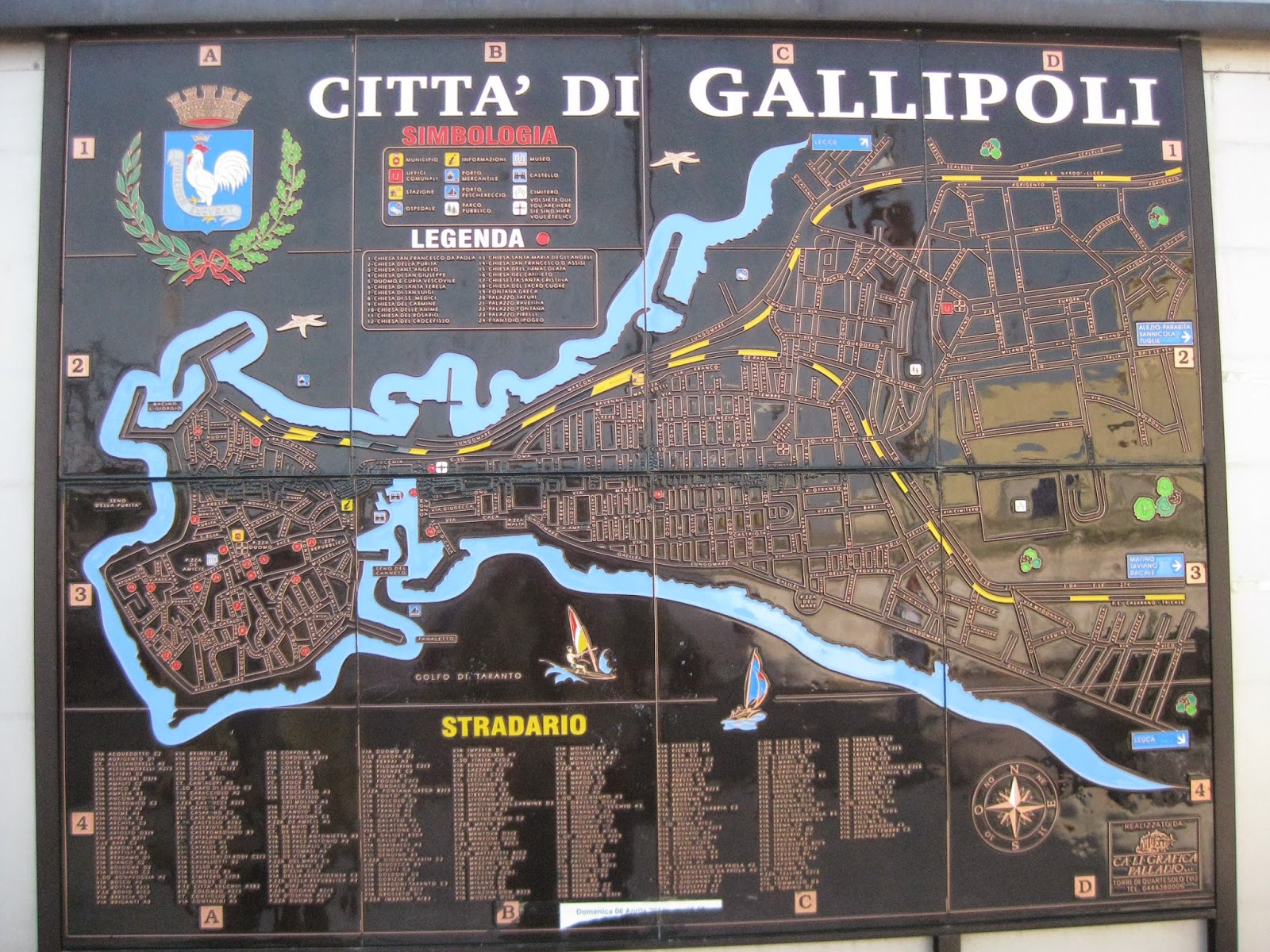Gallipoli
A 90-minute train ride through the relatively flat and productive (vineyards and olive trees) areas of the Salentina peninsula deposited us in Gallipoli ("beautiful city" in Greek).
The old part of the town is actually a small limestone island linked to the modern town by a small bridge built in the 16th century. As with so many places in the south of Italy, it was taken over first by the Greeks, and then Romans, and then the etc.
In the Middle Ages it was sacked by Vandals and Goths, but was rebuilt by the Byzantines and later owned by Roman Popes fighting against the Greek monastic orders. Then the Normans, Venetians, and Spanish--whew! The history in these areas of Italy's south makes the mind spin.
During the 18th century, a period of relative calm, Gallipoli became the largest olive oil market in the Mediterranean.
The lovely and sleepy town that we through which we walked had only the remains of the fortifications and many old churches to show for the centuries of high drama. And so we walked all around the old city walls and small streets of the town and, of course, found a cute and calm trattoria for a seafood lunch.
The food, especially the mussels, was fresh and delicious although still a bit heavy on the tomato sauce for our taste. Nevertheless, we enjoyed lunch, and then took a stroll through the modern town before taking the train back to Lecce.
Alberobello
We had seen so many pictures of trullis, and so many friends had raved about this area of Puglia that we decided it was time to spend a couple days actually living in a trullo! The town of Alberbello is trulli central and looks like a cross between a hobbit village and a random set of chess pieces. While most tourists stream to the trulli zones, the actual town where locals live and shop is equally lovely if less "cute."
 |
| Trullis throughout the countryside |
A trullo (singular, from the Greek word for cupola) is a dry stone hut with a conical roof. The style of construction is specific to this zone, the Murge river area of Puglia. Trulli were generally constructed as temporary field shelters or as permanent dwelling by small proprietors.
 |
| The trulli village of Alberobello |
The pinnacles have a variety of designs according to the stonemason who built them. The symbols painted on the top cone represent both Christian and pre-Christian and good luck signs.
 |
| Our very own trullo. |
 |
| Life inside a trullo |
Beginning in the 20th century the trullis began to be restored with bathrooms and kitchens and turned into homes and inns. They are now incredibly popular with visitors such as ourselves because of their unusual design and charm.
And so we passed two cozy and peaceful nights in our very own trullo (which was in fact three trulli that had been merged together), the only problem being Lee's height and his occasional collision with a trullo beam.
Castel del Monte
From Alberbello we decided to make the two-hour drive to visit the Castel del Monte built by Emperor Frederick II (Holy Roman Emperor) in 1240, on the summit of one of the highest Murge hills overlooking the sea.
Frederick II was an amazing historical character - a German, who although Holy Roman Emperor, spent as much of his life in Sicily rather than Germany as possible. He was a scholar, diplomat, warrior with a multi-cultural world view, having been raised in the city of Palermo with Arab, Byzantine, Norman and Latin influences. A fascinating historical note: Frederick won back Jerusalem in the 6th Crusade by diplomacy and was promptly excommunicated by the Pope for not shedding any Muslim blood in the process!
Frederick was closely involved with the construction of his many castles and fortresses built throughout Puglia. His constructions were based for the most part square based on the number four which was considered a magical number in the Middle Ages.
The square and the circle were considered symbols of earth and the sky, Man and God. Castel del Monte though was designed using the number eight--the octagon was considered a perfect balance between the circle and the square, blending the human and divine. Eight is used almost obsessively here--the castle is eight-sided, there are eight towers and each floor has eight rooms. Sounds a bit like Dan Brown should be here.
 |
| A bird's-eye view of the castle |
It is even today, nearly eight hundred years later, a beautiful and moving structure. Even the interior remains lovely because of the designs and views. Frederick's Castel del Monte even had an internal toilet system, inspired by the Arabs and by this time in common use in Sicily.







No comments:
Post a Comment